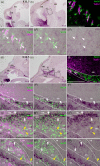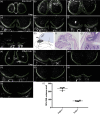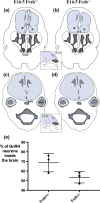Olfactory ensheathing cells abutting the embryonic olfactory bulb express Frzb, whose deletion disrupts olfactory axon targeting
- PMID: 30256452
- PMCID: PMC6517278
- DOI: 10.1002/glia.23515
Olfactory ensheathing cells abutting the embryonic olfactory bulb express Frzb, whose deletion disrupts olfactory axon targeting
Erratum in
-
Erratum.Glia. 2019 Dec;67(12):2440. doi: 10.1002/glia.23703. Epub 2019 Sep 4. Glia. 2019. PMID: 31605559 Free PMC article. No abstract available.
Abstract
We and others previously showed that in mouse embryos lacking the transcription factor Sox10, olfactory ensheathing cell (OEC) differentiation is disrupted, resulting in defective olfactory axon targeting and fewer gonadotropin-releasing hormone (GnRH) neurons entering the embryonic forebrain. The underlying mechanisms are unclear. Here, we report that OECs in the olfactory nerve layer express Frzb-encoding a secreted Wnt inhibitor with roles in axon targeting and basement membrane breakdown-from embryonic day (E)12.5, when GnRH neurons first enter the forebrain, until E16.5, the latest stage examined. The highest levels of Frzb expression are seen in OECs in the inner olfactory nerve layer, abutting the embryonic olfactory bulb. We find that Sox10 is required for Frzb expression in OECs, suggesting that loss of Frzb could explain the olfactory axon targeting and/or GnRH neuron migration defects seen in Sox10-null mice. At E16.5, Frzb-null embryos show significant reductions in both the volume of the olfactory nerve layer expressing the maturation marker Omp and the number of Omp-positive olfactory receptor neurons in the olfactory epithelium. As Omp upregulation correlates with synapse formation, this suggests that Frzb deletion indeed disrupts olfactory axon targeting. In contrast, GnRH neuron entry into the forebrain is not significantly affected. Hence, loss of Frzb may contribute to the olfactory axon targeting phenotype, but not the GnRH neuron phenotype, of Sox10-null mice. Overall, our results suggest that Frzb secreted from OECs in the olfactory nerve layer is important for olfactory axon targeting.
Keywords: GnRH neurons; OECs; Omp; Sox10; olfactory receptor neurons.
© 2018 The Authors. Glia published by Wiley Periodicals, Inc.
Figures







Similar articles
-
Olfactory ensheathing cells are the main phagocytic cells that remove axon debris during early development of the olfactory system.J Comp Neurol. 2015 Feb 15;523(3):479-94. doi: 10.1002/cne.23694. Epub 2014 Nov 3. J Comp Neurol. 2015. PMID: 25312022
-
Olfactory ensheathing glia are required for embryonic olfactory axon targeting and the migration of gonadotropin-releasing hormone neurons.Biol Open. 2013 Jun 21;2(7):750-9. doi: 10.1242/bio.20135249. Print 2013 Jul 15. Biol Open. 2013. PMID: 23862023 Free PMC article.
-
Shared Lineage, Distinct Outcomes: Yap and Taz Loss Differentially Impact Schwann and Olfactory Ensheathing Cell Development Without Disrupting GnRH-1 Migration.Glia. 2025 Oct;73(10):2077-2097. doi: 10.1002/glia.70057. Epub 2025 Jul 9. Glia. 2025. PMID: 40631762 Free PMC article.
-
The potential therapeutic applications of olfactory ensheathing cells in regenerative medicine.Cell Transplant. 2014;23(4-5):567-71. doi: 10.3727/096368914X678508. Cell Transplant. 2014. PMID: 24816451 Review.
-
Morphological and functional plasticity of olfactory ensheathing cells.J Neurocytol. 2005 Mar;34(1-2):65-80. doi: 10.1007/s11068-005-5048-6. J Neurocytol. 2005. PMID: 16374710 Review.
Cited by
-
Wnt antagonist FRZB is a muscle biomarker of denervation atrophy in amyotrophic lateral sclerosis.Sci Rep. 2020 Oct 7;10(1):16679. doi: 10.1038/s41598-020-73845-z. Sci Rep. 2020. PMID: 33028902 Free PMC article.
-
Frizzled related protein deficiency impairs muscle strength, gait and calpain 3 levels.Orphanet J Rare Dis. 2020 May 24;15(1):119. doi: 10.1186/s13023-020-01372-1. Orphanet J Rare Dis. 2020. PMID: 32448375 Free PMC article.
-
Erratum.Glia. 2019 Dec;67(12):2440. doi: 10.1002/glia.23703. Epub 2019 Sep 4. Glia. 2019. PMID: 31605559 Free PMC article. No abstract available.
-
Wiring the senses: Factors that regulate peripheral axon pathfinding in sensory systems.Dev Dyn. 2023 Jan;252(1):81-103. doi: 10.1002/dvdy.523. Epub 2022 Aug 30. Dev Dyn. 2023. PMID: 35972036 Free PMC article. Review.
-
Insights into olfactory ensheathing cell development from a laser-microdissection and transcriptome-profiling approach.Glia. 2020 Dec;68(12):2550-2584. doi: 10.1002/glia.23870. Epub 2020 Aug 28. Glia. 2020. PMID: 32857879 Free PMC article.
References
-
- Akins, M. R. , & Greer, C. A. (2006a). Axon behavior in the olfactory nerve reflects the involvement of catenin–cadherin mediated adhesion. The Journal of Comparative Neurology, 499, 979–989. - PubMed
-
- Amaya, D. A. , Wegner, M. , Stolt, C. C. , Chehrehasa, F. , Ekberg, J. A. K. , & St John, J. A. (2015). Radial glia phagocytose axonal debris from degenerating overextending axons in the developing olfactory bulb. The Journal of Comparative Neurology, 523, 183–196. - PubMed
-
- Au, W. W. , Treloar, H. B. , & Greer, C. A. (2002). Sublaminar organization of the mouse olfactory bulb nerve layer. The Journal of Comparative Neurology, 446, 68–80. - PubMed
-
- Balmer, C. W. , & LaMantia, A.‐S. (2005). Noses and neurons: Induction, morphogenesis, and neuronal differentiation in the peripheral olfactory pathway. Developmental Dynamics, 234, 464–481. - PubMed
Publication types
MeSH terms
Substances
Grants and funding
LinkOut - more resources
Full Text Sources
Other Literature Sources
Molecular Biology Databases
Research Materials

